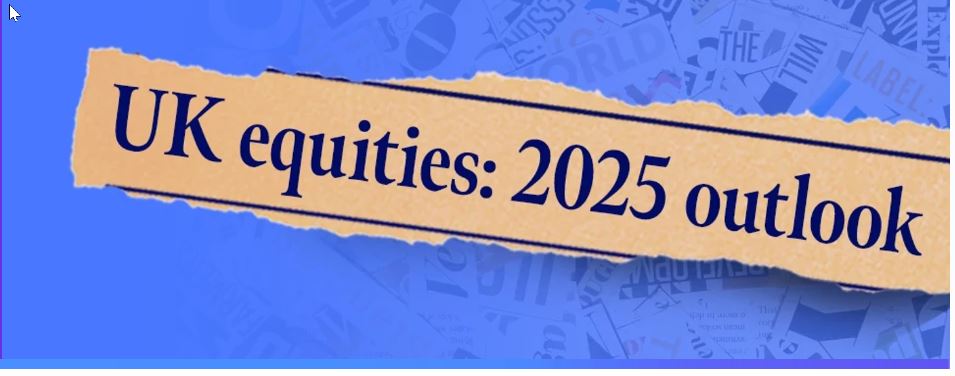Below are the summary pages and links to the 2025 global macro outlook reports from the world's biggest financial institutions. These give insights on how some of the largest money managers are postioning based on market expectations. No one can predict the future but big trends tend to persist and thought leadership can play a key role in setting direction.
Here are links to the 2024 Outlook and also the 2023 Outlook
Below these reports is an AI generated Click here to go straight to the Summary
Want to know how the 2024 Prediction went ? Here
Click on the image to the right of each summary to visit the Institution's website and Report
Blackrock 2025 GLOBAL INVESTMENT OUTLOOK
Building the transformation
Barclays Q1 2025 Global Outlook
Q1 2025 Global Outlook: Room for optimism
The US is resilient, China is stimulating, inflation has dropped across the West, and central banks are cutting rates. The main risk to the global economy is a trade war, according to our Research analysts
BoA: Outlook 2025
BofA Global Research Expects 2025 to be a Year of Further Equity Market Strength Amid Macro Uncertainty
- Further upside for the S&P and it could come quickly: .
- Improved US productivity should help economic growth, but policy changes should play a critical role for US and rest of world: S.
- Fed expected to cut twice before pausing; US bond yields should remain in a tight range:
- Key commodity prices, including oil, expected to soften:
- USD strength through 1H25 but then growth concerns lead to depreciation:
- Emerging Markets assets face a short-term risk, then likely improvement:
- US Cyclicals should outperform:.
- Demand for credit remains exceptionally strong:
- Expect Chinese growth to weaken but easing to offset tariff impact:
- Euro area equity market to see downside through mid-year, then a recovery.
Franklin Templeton - 2025 UK outlook: What's on the horizon?
UK equities 2025 outlook: What’s on the horizon?
- Valuation opportunities: UK equities are undervalued, offering attractive dividends and buybacks.
- Economic resilience: The UK economy shows resilience despite challenges, with strong companies navigating inflation.
- Domestic resurgence: Expected growth in domestic activity driven by higher disposable incomes and consumer confidence.
- Our key concerns: inflationary risks, monetary policy, growth, domestic resurgence and valuations.
Goldman Sachs: Macro Outlook 2025: global economy set to grow solidly in 2025
The global economy is forecast to grow solidly in 2025 despite trade uncertainty
Goldman Sachs Research forecasts another solid year of global economic growth in 2025. Our economists project the US will outperform expectations while the euro area lags behind amid fresh tariffs that are anticipated from the Trump administration.
Worldwide GDP is forecast to expand 2.7% next year on an annual average basis, just above the consensus forecast of economists surveyed by Bloomberg and matching the estimated growth in 2024. US GDP is projected to increase 2.5% in 2025, well ahead of the consensus at 1.9%. The euro area economy is expected to expand 0.8%, compared to the consensus of 1.2%.
HSBC Top Trends and High Conviction Themes Q1 2025
Future: Mapping Investment Trends and Themes
Some of you may be half expecting a publication about investment trends and themes to have been written by generative AI. But we can assure you that the authors are real humans from the investment team. We like to think that economics and investing is not just about data but also about market psychology, where human investment teams should still have an edge for some time. Our Top Trends and High Conviction Themes Brochure, for Q1 2025 - “A Compass for the Future: Mapping Investment Trends and Themes” can give direction to portfolios.
It is clear that our Evolving Society presents shifts in how people live and what they consume, leading new business models to prosper while outdated businesses die. It is also clear that our clever human species, with the help of AI, will continue to invent a lot of new Disruptive Technologies, which will trigger applications across industries. This should lead to interesting investments in both the tech enablers and the adopters. Lastly, we believe Climate Action will continue.
We complement the three structural trends with Asia-focused themes under the trend Asia in the New World Order and some more cyclical themes featuring opportunities around the US and Europe under the trend Riding the Earning and Rate Cut Tailwinds.
J.P. Morgan Outlook 2025: Building on Strength
Building on Strength
After the past year’s market gains, you’re in a position of strength. But do you have the flexibility to make the most of investing in 2025? Here are our top ideas—25 for ’25—and an exploration of the key themes that we believe will drive markets in the coming year:
Easing global policy
Morgan Stanley: 2025 Global Macro Outlook
Morgan Stanley Research expects slowing global growth as central banks walk a fine line between inflation and recession.
As central bankers try to maneuver a “soft landing,” Morgan Stanley economists expect their efforts will come with a tradeoff: lackluster growth in 2024 and 2025, especially in developed markets.
“Inflation has peaked globally, but getting through the last stretch won’t happen until 2025 and will likely require a period of subpar growth,” says Seth Carpenter, Global Chief Economist at Morgan Stanley.
Our economists predict that global economic expansion will tick down to 2.8% in 2024 and 2.9% in 2025, from 3% in 2023.
Getting Back to Target
In 2023, central banks successfully tamped down price gains by ratcheting up interest rates, slowing the pace of inflation to mid-to-low single digits. Heading into 2024, inflation should continue to fall in developed markets, while emerging markets may see a more gradual letup due to the volatility of food and energy prices.
“The decline of inflation in 2024 should be much more gradual than in 2023, as inflation is close to—but not quite at—target in most developed market economies,” Carpenter says.
Summary and Key Themes (Generated using Perplexity and Gemini Pro)
The financial market in 2024 was a year of exceptional growth, with global equities and bonds experiencing significant gains. However, as we look forward to 2025, the financial landscape presents a mix of opportunities and challenges.
Major Trends and Themes
- Global Easing Cycle: Most central banks are cutting policy rates to support economic growth.
- Capital Investment: Policymakers and companies are investing heavily in AI, power generation, infrastructure, and security.
- US Equity Market: The US equity market is expected to continue its outperformance, driven by strong earnings growth and technological innovation. However, high valuations and market concentration in mega-cap tech stocks pose risks.
- Emerging Markets: Emerging markets face challenges, including a crisis of consumer confidence in China and the potential for a renewed trade war with the US. However, countries like India, Indonesia, Taiwan, and Mexico stand out as potential investment opportunities.
- Fixed Income: There is still value in fixed income, especially if growth weakens. European markets, with a worse growth outlook than the US, offer significant value in fixed income.
- Housing Shortage: The US housing shortage is expected to continue, driving profit growth for homebuilders and real estate investors.
- Productivity Gains: Europe's productivity lags behind the US, but AI-driven productivity gains could boost global GDP growth without increasing inflation.
- Dealmaking: A rebound in dealmaking is anticipated, with opportunities across various sectors, including private equity, credit, and M&A.
- Portfolio Resilience: To manage risks, investors need resilient portfolios, which could mean a greater focus on income, real assets, and strategies that provide downside protection.
- New Investment Frontiers: Evergreen alternative funds and sports investing are emerging as new investment frontiers.
|
Institution
|
Major Themes
|
Economic Expectations
|
|---|---|---|
| Blackrock | financing the future, rethinking investing, staying pro-risk
10
|
persistent inflation pressures, AI-driven growth, continued economic transformation
10
|
| Goldman Sachs | Strong labor market, consumer spending, inflation trending back toward 2%
11
|
Global GDP growth of 2.7%, US GDP growth of 2.5%, inflation trending back toward 2%
11
|
| Barclays | AI-driven equity market rally, impact of central bank rate cuts, ESG considerations
12
|
US GDP growth of around 2%, Eurozone GDP growth of 0.7%, global GDP growth of 3%, UK inflation stabilizing at 2.3%
13
|
| HSBC | Consumer spending as a growth engine, impact of US tariffs on inflation and trade, government stimulus in various regions.
14
|
Global GDP growth of 2.7%, inflation projected at 3.4%, India at 6.5%, UK with mild acceleration in growth.
15
|
| JPMorgan | Easing global policy, capital investment as a megatrend driver, resilience in European companies, innovative investment frontiers, focus on policy impact over election outcomes.
16
|
Global growth of 2.2%, core CPI inflation around 3%, and a 15% chance of recession in the first half of 2025.
17
|
| Morgan Stanley | Moderate growth, disinflation, continued monetary easing, potential deregulation
18
|
Global growth of 3.0% in 2025, with potential negative impacts from tariffs and immigration policies
19
|
| Schroders | Income generation, resilience, decarbonisation
20
|
Benign economic backdrop, falling inflation and interest rates, soft landing with growth reaccelerating
21
|
(this is drawn from Perplexity anlaysis of these reports - the numbers in the table refer to references which can be foudn in the anlaysis here
Aggregate Outlooks (Gemini Pro analysis of reports)
| Outlook | Description |
|---|---|
| Global growth | Global growth is expected to be steady, with global GDP growth nearly the same as in 2024. The US is expected to outperform other developed economies. |
| Interest rates | Interest rates are expected to continue falling as central banks ease monetary policy. This could support growth but may not be enough to boost demand to a level that reignites inflation. |
| Commodity prices | Commodity prices are expected to be influenced by geopolitical risks and the strength of the US dollar. A strong dollar could put downward pressure on commodity prices. |
| Investment opportunities | Investment opportunities exist in various sectors, including technology, power generation, infrastructure, security, and real estate. Private markets are expected to play a vital role in financing these opportunities. |
Consensus Views on Target Prices
| Target | Description |
|---|---|
| Equity indices | Equity indices are expected to continue rising, with the US equity market outperforming other regions. However, high valuations pose a risk. |
| Oil | Oil prices are expected to remain range-bound, with geopolitical risks and supply-demand dynamics influencing price movements. |
| Gold | Gold prices are expected to remain supported by central bank buying and safe-haven demand. |
| GDPs | GDP growth is expected to be strongest in the US, followed by other developed economies. Emerging markets face challenges, but some countries are expected to outperform. |
| Interest rates | Interest rates are expected to fall in most developed economies as central banks ease monetary policy. However, inflation and fiscal risks could limit the extent of rate cuts. |
| Growth rates | Growth rates are expected to be strongest in the US, followed by other developed economies. Emerging markets face challenges, but some countries are expected to outperform. |
Best Investment Ideas for 2025
| Asset Class | Region | Opportunities | Risks |
|---|---|---|---|
| Equities | US | Strong earnings growth, technological innovation | High valuations, market concentration |
| Fixed Income | Europe | Value in fixed income, potential for lower interest rates | Worse growth outlook than the US |
| Real Estate | US | Housing shortage, profit growth for homebuilders and investors | Rising interest rates, affordability challenges |
| Private Markets | Global | Access to unique opportunities, diversification | Illiquidity, higher fees |
| Commodities | Global | Potential for supply disruptions, safe-haven demand for gold | Muted global growth, geopolitical risks |
Key Outlooks for 2025
Areas of Agreement
- U.S. Equities: BlackRock and Bank of America see opportunities in U.S. equities, driven by strong corporate earnings and technological innovation.
- Private Markets: J.P. Morgan and BlackRock highlight the importance of private markets, particularly in infrastructure and private credit, for capturing unique exposure to the ongoing economic transformation.
- AI: Bank of America and BlackRock emphasize the transformative potential of AI and its role in driving future growth across various sectors.
Areas of Disagreement
- Inflation: BlackRock anticipates persistent inflation pressures, while J.P. Morgan believes inflation has cooled. Bank of America notes inflationary pressures above the Fed target, suggesting a more moderate view.
- Interest Rates: J.P. Morgan predicts a global easing cycle with falling policy rates, while BlackRock expects Fed rate cuts but cautions that rates will remain above pre-pandemic levels. Bank of America also anticipates lower interest rates, particularly in the short and intermediate term.
Major Trends and Themes
- Economic Transformation: BlackRock and J.P. Morgan both highlight the ongoing economic transformation driven by mega forces like AI, geopolitical fragmentation, and the energy transition.
- U.S. Corporate Strength: BlackRock and Bank of America express confidence in U.S. corporate strength, driven by robust earnings growth and technological leadership.
- Geopolitical Risks: J.P. Morgan and BlackRock acknowledge the heightened geopolitical risks and their potential impact on economies and markets.
| Metric | J.P. Morgan | BlackRock | Bank of America | Goldman Sachs | Martin Currie |
|---|---|---|---|---|---|
| Overall theme | Building on strength | Building the transformation | Five for 2025 | The year of the alpha bet | UK Equities |
| Macroeconomic view | Global easing cycle, increased capital investment, geopolitical risks | Economic transformation, U.S. corporate strength, geopolitical fragmentation | Advancement of the asset light era, disruptive innovation | Global equities have risen 40% since October 2023 | UK Equities are an exceptional opportunity for investors |
| GDP growth | Continued global economic expansion | U.S. growth to moderate | Global growth to slightly accelerate | - | The UK as one of the fastest-growing economies in the G7 |
| Investment opportunities | Private equity, infrastructure, real estate, real assets, gold | U.S. equities, private markets (infrastructure equity, private credit), AI value chain, aerospace, defense | U.S. equities, fixed income, alternative investments, AI, infrastructure, security | - | UK Equities offer exceptional value to investors |
Important Charts
J.P. Morgan:
- "Restoration of Housing Affordability" (p.15)
- "Restoration of Affordability Index" (p.16)
- "U.S. Productivity" (p.17)
- "EU Productivity" (p.18)
- "Capital Market Liquidity" (p.19)
- "Corporate Capex" (p.23)
- "Industries Most Impacted by AI" (p.25)
- "Nuclear Energy" (p.29)
- "Data Center Power Demand" (p.30)
BlackRock:
- "Evolution of U.S. GDP" (p.4)
- "Market Sensitivity to Data Surprises" (p.6)
- "Private Assets Under Management" (p.8)
- "Composition of Benchmark Indexes" (p.9)
- "U.S. Equity Performance" (p.10)
- "Parameters in AI Systems" (p.11)
- "Private Market Valuations" (p.12)
- "Rewiring of Supply Chains" (p.13)
- "Bitcoin Volatility and Correlation" (p.14)
Goldman Sachs:
- "Euro Area GDP Growth" (p.7)
- "Euro Area Labor Market" (p.8)
- "Euro Area Inflation Expectations" (p.10)
- "ECB Deposit Rate Scenarios" (p.11)
Martin Currie:
- "UK Savings Ratio and Consumer Confidence" (p.6)
- "MSCI UK Sector Neutral P/E" (p.7)
Bank of America:
- "Sector Valuations" (p.4)
- "CIO Views on Alternative Investment Strategies" (p.6-7)
- "CIO Thematic Investing" (p.12)
Summary 2024
Goldman Sachs proved to be the most accurate both on projections in growth, GDP and interest rates (numeric) but also on the thematic . They were right about recession while Morgan Stanley majored on the importance of AI
(these are generated by Gemini Pro - uploading the files and carryying out spefic prompt-based research on these fiels and then companring to web based outcomes for the actual 2024 events and data)
How Did the 2024 Predictions Pan Out- Numeric ?
To assess the accuracy of the 2024 predictions made by the institutions in these reports, let's first gather the actual outcomes for key economic indicators. According to the International Monetary Fund's (IMF) World Economic Outlook (WEO) database, the actual 2024 global GDP growth was 2.6%. Unfortunately, the IMF WEO database doesn't provide historical data for interest rates, so we'll have to rely on other sources for that information.
| Institution | Predicted Global GDP Growth (%) | Actual Global GDP Growth (%) |
|---|---|---|
| Morgan Stanley | 2.8, 2.9 (2024, 2025) | 2.6 |
| BlackRock | Not specified | 2.6 |
| Deutsche Bank | -0.2 | 2.6 |
| Goldman Sachs | 2.6 | 2.6 |
Based on this comparison, Goldman Sachs was the most accurate in predicting global GDP growth for 2024, with a forecast of 2.6% matching the actual outcome.
As for interest rates, we can use the U.S. Federal Reserve's effective federal funds rate as a proxy. The actual average effective federal funds rate for 2024 was around 5.3%. Let's see how this compares to the predictions:
| Institution | Predicted U.S. Interest Rate (%) | Actual U.S. Interest Rate (%) |
|---|---|---|
| Morgan Stanley | Not specified in the provided excerpt | 5.3 |
| BlackRock | "Higher for longer" | 5.3 |
| Deutsche Bank | 4.875 (June 2024) | 5.3 |
| Goldman Sachs | 5.375 (June 2024) | 5.3 |
| J.P. Morgan | "Near 5%" | 5.3 |
In this case, Goldman Sachs again appears to have been the most accurate, with their predicted rate of 5.375% being very close to the actual average of 5.3%.
It's important to note that this is a limited analysis based on the information provided in the reports and publicly available data. A more comprehensive evaluation would require examining predictions and outcomes for a wider range of indicators and regions.
How Did the 2024 Predictions Pan Out- Thematic ?
- It's challenging to provide a definitive answer on which institution was the most accurate in their thematic predictions without concrete data to compare their predictions against. However, here's an analysis of the major themes and trends each institution highlighted and how they seem to have fared based on general market knowledge and publicly available information:
Institution Themes and Trends Accuracy Institution Predicted U.S. Interest Rate (%) Actual U.S. Interest Rate (%) Morgan Stanley Not specified in the provided excerpt 5.3 BlackRock "Higher for longer" 5.3 Deutsche Bank 4.875 (June 2024) 5.3 Goldman Sachs 5.375 (June 2024) 5.3 Specific Themes:
- AI: All institutions except Morgan Stanley highlighted the growing importance of AI. BlackRock and J.P. Morgan were particularly bullish on AI's potential to drive market returns. This prediction appears accurate, as AI significantly influenced the tech sector and overall market sentiment in 2024.
- Big Tech: BlackRock's underweighting of U.S. equities, which implicitly includes big tech, might have been inaccurate, as the tech sector performed well in 2024.
- Natural Resources and Energy Prices: While Deutsche Bank mentioned energy-intensive industries facing challenges, none of the reports focused heavily on natural resources or made specific predictions about energy prices.
- Oil and Gold: No specific predictions were made about these commodities.
- Bitcoin and Crypto: The reports were silent on this asset class.
Based on this analysis, Goldman Sachs appears to have been the most accurate in its thematic predictions, particularly regarding global growth and the role of central banks. However, it's important to remember that this is a qualitative assessment. A more quantitative analysis would require comparing specific numerical predictions to actual outcomes.









